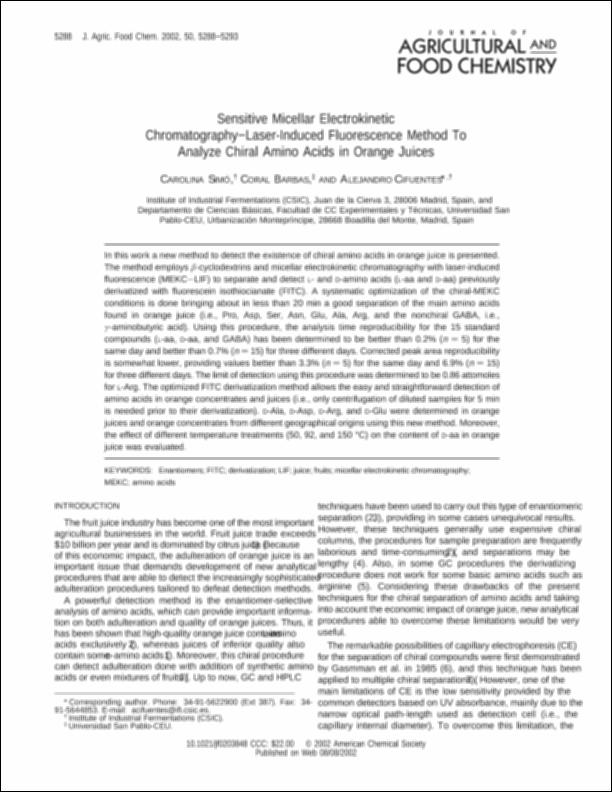Please use this identifier to cite or link to this item:
http://hdl.handle.net/10637/1094A sensitive micellar electrokinetic chromatography-laser induced fluorescence method to analyze chiral amino acids in orange juices.
| Title: | A sensitive micellar electrokinetic chromatography-laser induced fluorescence method to analyze chiral amino acids in orange juices. |
| Authors : | Simó, Carolina Barbas Arribas, Coral. Cifuentes, Alejandro |
| Keywords: | Enantiomers.; FITC.; Derivatization.; LIF.; Juice.; Fruits.; Micellar electrokinetic chromatography.; MEKC.; Amino acids. |
| Abstract: | In this work a new method to detect the existence of chiral amino acids in orange juice is presented. The method employs â-cyclodextrins and micellar electrokinetic chromatography with laser-induced fluorescence (MEKC-LIF) to separate and detect L- and D-amino acids (L-aa and D-aa) previously derivatized with fluorescein isothiocianate (FITC). A systematic optimization of the chiral-MEKC conditions is done bringing about in less than 20 min a good separation of the main amino acids found in orange juice (i.e., Pro, Asp, Ser, Asn, Glu, Ala, Arg, and the nonchiral GABA, i.e., ç-aminobutyric acid). Using this procedure, the analysis time reproducibility for the 15 standard compounds (L-aa, D-aa, and GABA) has been determined to be better than 0.2% (n ) 5) for the same day and better than 0.7% (n ) 15) for three different days. Corrected peak area reproducibility is somewhat lower, providing values better than 3.3% (n ) 5) for the same day and 6.9% (n ) 15) for three different days. The limit of detection using this procedure was determined to be 0.86 attomoles for L-Arg. The optimized FITC derivatization method allows the easy and straightforward detection of amino acids in orange concentrates and juices (i.e., only centrifugation of diluted samples for 5 min is needed prior to their derivatization). D-Ala, D-Asp, D-Arg, and D-Glu were determined in orange juices and orange concentrates from different geographical origins using this new method. Moreover, the effect of different temperature treatments (50, 92, and 150 °C) on the content of D-aa in orange juice was evaluated. |
| Description: | En: Journal of agricultural and food chemistry, ISSN 0021-8561, 2002. vol. 50 : 5288-5293 p. |
| URI: | http://hdl.handle.net/10637/1094 |
| Rights : | http://creativecommons.org/licenses/by-nc-nd/4.0/deed.es |
| Issue Date: | 19-Sep-2002 |
| Center : | Universidad San Pablo-CEU |
| Appears in Collections: | Facultad de Farmacia |
Items in DSpace are protected by copyright, with all rights reserved, unless otherwise indicated.


